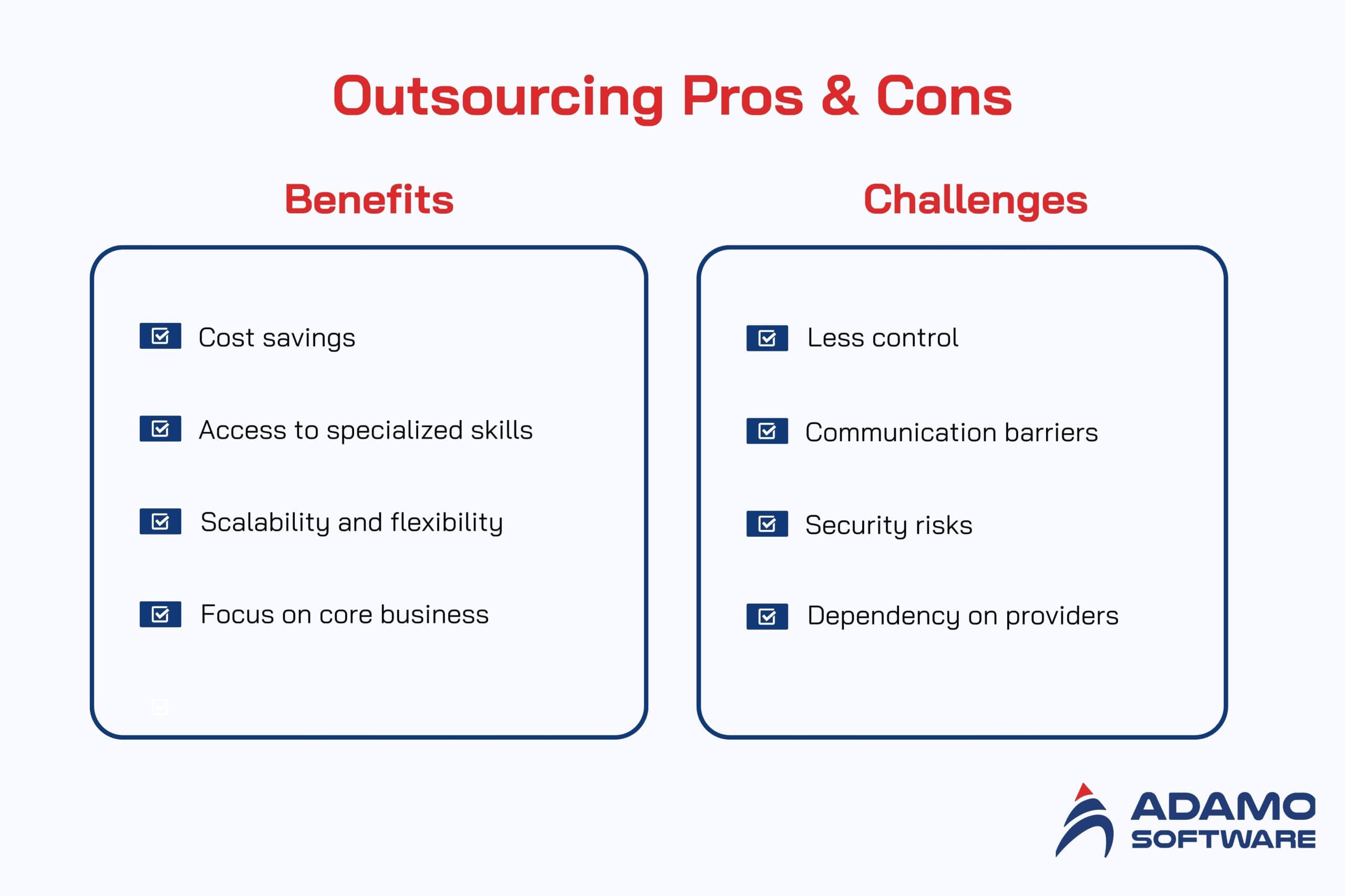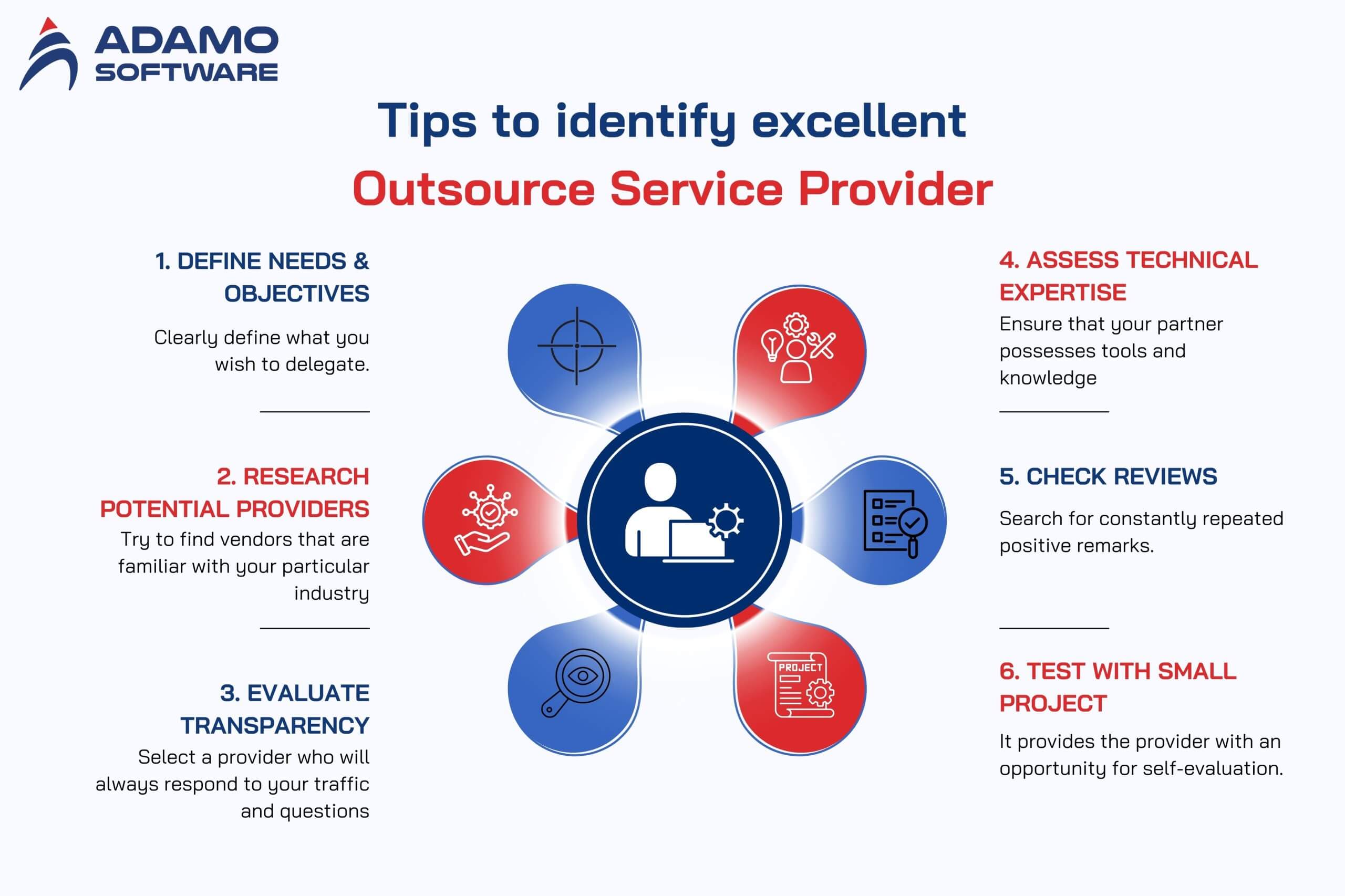Benefits of Insourcing vs Outsourcing: Pros, Cons and Case Studies

Insourcing and outsourcing are two critical strategic decisions any company has to make in the current production world. Each has benefits and drawbacks. Knowing them can assist in choosing the right method. Insourcing is an internal way of performing the work. Outsourcing means the work is sent to other people, usually to other companies. But how can you tell if this former one is better suited for your needs?
So, in this article, let us take a closer look at insourcing vs outsourcing to enable you to decide. Here you will find information on the benefits of insourcing vs outsourcing, and their drawbacks. You will also find the better one for your business and consider examples from practice. Also, there will be recommendations on where to find great outsourcing providers if you decide to take this path. We will explain at the end whether the benefits of insourcing vs outsourcing are more advantageous by the end of this paper.
I. Benefits of Insourcing vs Outsourcing: What to choose?
Self-performance vs outsourcing is a common consideration when managing different operations within a business. Each approach has its merits, similarities, demerits, and differences. The best category depends on the goals, resources, and priority of the organization participating in the show. The drawbacks and benefits of insourcing vs outsourcing shall be discussed further to assist you in making the right decision.
1. Insourcing Pros & Cons
Insourcing entails managing work activities, projects, or processes locally within the organization. Here are its advantages and disadvantages:

Pros of Insourcing:
- Full Control Over Processes: Insourcing gives you full authority to run an operation from within your organization. This helps make a performance more relevant to the firm’s goals and objectives.
- Improved Communication: In addition, insourcing strengthens your team’s cooperation. They are located in the same building and share the same working space. This makes communication effective.
- Tailored Skill Development: It also improves the expertise inside an organization by training employees to fit the organization’s needs.
- Confidentiality and Security: Because all the processes remain internal, there is little chance of compromising vital information.
Cons of Insourcing:
- Higher Costs: Insourcing requires salaries, infrastructure, training, and tools, which can debilitate budgets, especially for smaller businesses.
- Limited Access to Expertise: You might not always have the specialized skills needed for certain tasks. This leads to slower results or lower quality.
- Scalability Challenges: Expanding operations through insourcing takes time and resources, making scaling harder.
- Resource Dependency: Relying solely on internal resources may limit your ability to adapt to sudden changes in demand.
2. Outsourcing Pros & Cons
Outsourcing is delegating certain unit operations to organizations other than the firm that needs the service. This approach is common for efficiency’s sake and broad access to certain specialized knowledge.

Pros of Outsourcing:
- Cost Savings: Outsourcing is less costly than in-house because it doesn’t require acquiring staff, facilities, or equipment for full-time use.
- Access to Specialized Skills: Outsourcing provides you with personnel who have worked for quite a long time in their respective fields. Hence it provides quality services.
- Scalability and Flexibility: They can easily increase or reduce the number of staff. That makes outsourcing flexible for your business.
- Focus on Core Business: Outsourcing nonbusiness activities means your internal team may focus only on business activities that would drive performance.
Cons of Outsourcing:
- Less Control: When tasks are outsourced, there could be little or no management over processes, quality, and time.
- Communication Barriers: Co-ordination with external teams, especially in different parts of the world causes a lot of complications.
- Security Risks: The data flow to third parties comes with the likely chance of exposing that information to hackers or leakages.
- Dependency on Providers: Situations may arise when an external provider fails to provide the services or may terminate the contract with the organization.
A clear demarcation between the benefits of insourcing vs outsourcing is crucial for any organization that is keen on expanding. Insourcing gives necessary control, safety, and customized services. However, it is expensive with significant scalability problems. Meanwhile, outsourcing is affordable, versatile, and available. However, it has drawbacks such as lack of control or confidentiality. Making a comparison between the weaknesses and benefits of insourcing vs outsourcing enables you to select a strategy that would be best suited for a particular objective.
II. How to decide: Insource vs Outsource?
The decision of whether to insource or outsource a particular activity can be difficult. Both have their pros and cons. It has some contingent factors such as your company’s objectives, resource constraints, and working requirements. Below we are explaining how to approach the decision-making and determinants of insourcing and outsourcing:

1. Assess Your Business Needs
If it is to give valuable solutions, it is crucial to begin with an analysis of the existing corporate needs and strategic targets. If a task requires unique skills or relates to a particular industry or activity, it is better to outsource it to another party. Another advantage is that outside suppliers can provide qualified people and effective equipment. On the other hand, if the task demands close supervision, frequent information exchange, or enjoys strategic importance to your enterprise, it is best to insource.
Whether the task is well aligned with the long-term vision and mission. For instance, you may want to use insourcing to strengthen competency within your organization while promoting employee teamwork. On the other hand, outsourcing enables the quick outsourcing of activities without putting much pressure on internal resources in scaling up operations on key activities.
2. Analyze Your Budget
Based on budget, business organizations can determine whether it is better to insource or outsource. Insourcing, in general, may entail greater costs in the initial stage including searching for full-time workers or trainers, and building and equipping structures. Such costs are rather prohibitive – more so when it comes to small businesses with constrained cash flows.
Contrary to this, outsourcing is usually cheaper. Because outsourcing companies have invested heavily in determining the optimum price for every service they offer. As it enables them to only pay for specific services. There will be no need for infrastructure costs such as staff and workplace. Nonetheless, whilst outsourcing can start with a seemingly lower cost price, costs such as contract management or quality assurance can quickly add up.
3. Evaluate the Complexity of the Task
Another one is in terms of the complexity of the task or the project about insourcing vs outsourcing. If a task requires petty, mundane, and ceremonial tasks to be carried out or done frequently, outsourcing can be productive. Several organizations hire or contract out work processes such as call center services or a clerk that inputs data.
Nevertheless, the source selection method such as insourcing may be necessary, if the job is intricate and delicate, or regularly innovated. In-house teams also know the organizational culture, its values, and requirements. This might sometimes be beneficial for such projects, the study noted.
4. Consider Time and Scalability
The constraints are the limited amount of time that an organization takes to decide whether to insource or outsource. When there is a need to advance a solution in record time, outsourcing offers existing know-how, equipment, and workforce. This is particularly beneficial when a company is looking to quickly grow or even diversify into new markets.
With this context in mind, insourcing is better for organizations that are interested in long-term stable solutions. Soon, one may hire people and provide all the necessary training. It will pay off, as the employees will be loyal, and the work – of high quality.
5. Weigh Security and Confidentiality
This part of the decision-making process cannot ignore matters of security regarding deciding which option is best between insourcing and outsourcing. From the perspective of protection for certain content including customer information and corporate secrets, insourcing may have the advantage. Staff in-house are not likely to leak any compromising information and this cuts risks.
Outsourcing has the disadvantage of information security since it is managed by a third party. To avoid this, select a good outsourcing partner. They should be able to honor and implement data security measures that are recommended in the market.
Outsourcing and insourcing both are strategies that completely depend on the requirements, goals, budget, and vision of the organization. When comparing the benefits of insourcing vs outsourcing, which action is proper, factors such as complexity, cost, time, and security must be considered. There is greater and direct control, and flexibility to collaborate and build long-term utility in insourcing than there is in outsourcing. Yet outsourcing has the attributes of flexibility, cost control, and quick scalability. By considering them, you get to make the correct decision when it comes to your business and realizing your objectives.
Also read: Insourcing vs Outsourcing cost analysis: What is more cost-effective?
III. Insourcing vs Outsourcing: Case studies
So, there is nothing wrong with focusing on insourcing vs outsourcing examples to get the real picture of things. The cases show that both strategies are used by various companies across industries and both strategies come with their own set of problems. Here you’ll learn about these approaches and how best to use them regarding these case studies on your business venture.
1. Insourcing for Operational Control
One of the leading software development companies wanted to bring the customer support function in-house to enhance the latter. The company decided to outsource services to minimize expenses. External teams have less experience than internal teams in dealing with issues concerning the product. Therefore, their efficiency is low.
The constraints are the limited amount of time that an organization takes to decide whether to insource or outsource. When there is a need to advance a solution in record time, outsourcing offers existing know-how, equipment, and workforce. This is particularly beneficial when a company is looking to quickly grow or even diversify into new markets.
With this context in mind, insourcing is better for organizations that are interested in long-term stable solutions. Soon, one may hire people and provide all the necessary training. It will pay off, as the employees will be loyal, and the work – of high quality.
2. Outsourcing for Cost Efficiency and Expertise
This part of the decision-making process cannot ignore matters of security regarding deciding which option is best between the benefits of insourcing vs outsourcing. From the perspective of protection for certain content including customer information and corporate secrets, insourcing may have the advantage. Staff in-house are not likely to leak any compromising information and this cuts risks.
Outsourcing has the disadvantage of information security since it is managed by a third party. To avoid this, select a good outsourcing partner. They should be able to honor and implement data security measures that are recommended in the market.
3. Mixed Approach for Scalability
Outsourcing and insourcing are both strategies that completely depend on the requirements, goals, budget, and vision of any business organization. When comparing insourcing and outsourcing, which action is proper, factors such as complexity, cost, time, and security must be considered. There is greater and direct control, and flexibility to collaborate and build long-term utility in insourcing than there is in outsourcing. Yet outsourcing has the attributes of flexibility, cost control, and quick scalability. By considering them, you get to make the correct decision for your business and realize your objectives.
So, there is nothing wrong with focusing on insourcing vs outsourcing examples to get the real picture of things. The cases show that both strategies are used by various companies across industries. Both strategies come with their problems. Here you’ll learn about these approaches and how best to use them in your business venture.
One of the leading software development companies wanted to bring the customer support function in-house to enhance the latter. Outsourcing support services will help to minimize expenses. External teams have less experience than internal teams in dealing with issues concerning the product. Therefore, their efficiency is low.
On the other hand, outsourcing can be the best way to reduce your costs, get access to specific skills, and scale up your team. So, businesses can have the objectives fulfilled for each approach while making the decision based on real-life circumstances.
IV. Tips to identify excellent outsource service provider
The greatest asset in outsourcing is identifying the right partner for your business to be a success. Outside service providers that extend full support can significantly contribute to promoting the benefits of insourcing vs outsourcing. It produces higher quality work to ensure that the project is completed on or before the deadline and by the goals set. Below are some clear ways to look for the right outsourcing partner for your business:

1. Define Your Needs and Objectives
This process should begin before scouting for an outsourcing partner. You need to determine your needs and wants. Clearly define what you wish to delegate, the competencies you require, and the expected results. From the above list, this clarity will enable a user to filter through the providers that can offer the service.
For example, if you object to obtaining a cost-effective solution that will help to attract the best providers, try to find those who have the experience and offer relatively low prices. However, if the scalability of the IT services is the main aspiration, it is better to pay attention to the vendors with experience in managing maneuverable workloads. Insourcing vs outsourcing requires a clear objective to derive optimal gains.
2. Research and Shortlist Potential Providers
Do not rush when it comes to outsourcing providers because you will get what you pay for. If possible, try to find vendors that are familiar with your particular industry because they will comprehend your problem. Our rationale for seeking out effective health providers is to focus on online referrals and reviews.
Check out their portfolio services and the cases they have handled to determine their competence and effectiveness. This is one of the factors that hold that the capability of the provider to complete such projects can be deemed as evidence of their aptness. This research guarantees the benefits of insourcing vs outsourcing by collaborating with a competent team to get the best results.
3. Evaluate Communication and Transparency
The working relationships can only be harmonious if the parties involved have effective communication during outsourcing. It is good to select a provider who will always respond to your traffic and questions. They should provide a clear outlook on what is expected. Even in the course of a general conversation, one should determine whether the person can define your objectives and give distinct solutions.
Inquire about their communication channel and frequency, how often are they receiving updates, how are they receiving the updates, and who from. Pricing, timelines, and deliverables must be both clear to the clients and rational. A good provider should describe possible risks and obstacles encountered when investing and present reasonable solutions to tackle.
4. Assess Technical Expertise and Resources
Another advantage flowing from the consideration of insourcing over outsourcing is the ability to access key skills and assets. Ensure that your partner possesses tools and knowledge.
To get a first-hand impression of the candidates’ performance, do interviews or ask for samples of work. You should get to know if their team members are competent, the preferences they have when choosing technologies, and how they ensure quality. An able provider will have adequate knowledge and instruments to provide quality service.
5. Check References and Reviews
Outsourcing provider references and reviews is important when comparing various providers. Get phone numbers of previous clients and inquire from them if they had a pleasant encounter with your firm. This feedback will help you get information about how often you can rely on the selected provider and how qualified is the provider’s team. You will also know whether they can complete the task before the due date.
Online reviews and testimonials can also be helpful in a way to gather information. One should search for constantly repeated positive remarks more so focusing on the provider’s professionalism, communication, and knowledge. This is how checking references assists in decreasing possible risks and experiencing as many benefits of insourcing vs outsourcing as possible.
6. Test with a Small Project
Also, before agreeing to a long-term relationship, you might want to begin with a trial: a small business. It provides the provider with an opportunity for self-evaluation in terms of friendliness, performance, and communication with the business.
Find out if the results align with your expectations. If the provider shows efficiency, quality of the completed work, and reliability, then, you can move forward. This helps in minimizing the risks and benefits of insourcing vs outsourcing.
Therefore, to successfully implement the strategy of insourcing versus outsourcing, it is necessary to choose an outstanding outsourcing service provider. By identifying the needs, evaluating the probable vendors, and comparing their capabilities you can come out with a conclusion. Concentrate on the aspect of communication, openness, and customer satisfaction to look for a suitable partner. When choosing the right provider you can reach the goals of reducing costs and getting access to special skills. Therefore, you can increase business effectiveness and productivity.
V. Contact us at Adamo Software to make the right decisions
Choosing insourcing or outsourcing is never easy but let us at Adamo Software assist you in making the right decision. Based on our vast experience in creating enterprise-specific products, we assist organizations in making a decision. Our team assesses your requirements and educates you on why you should either insource or outsource depending on the objectives you set.
We provide several services including software development, project management, and IT consulting. Regardless of whether you want to develop your in-house advertising team or delegate certain activities to an advertising agency, we offer the resources, analytics, and tips to do so successfully. When you partner with us, you will maximize the benefits of insourcing vs outsourcing. Therefore, you will expand your business effectively.

Do not hesitate to contact us at Adamo Software now and let us turn your business into smart choices. In developing the framework of the plan, we will work together towards achieving your vision. We will have it done within your financial capacity and concerning your goals and objectives.











